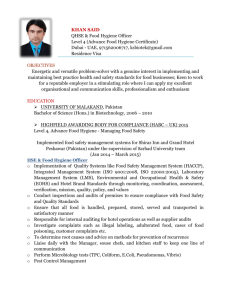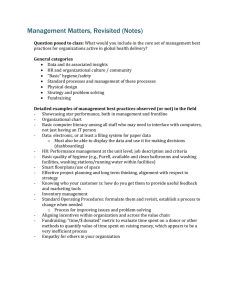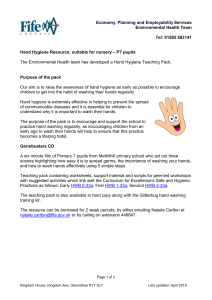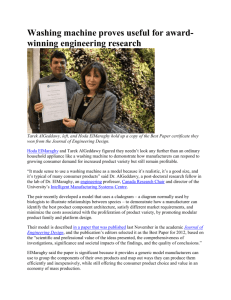Document 14104679
advertisement
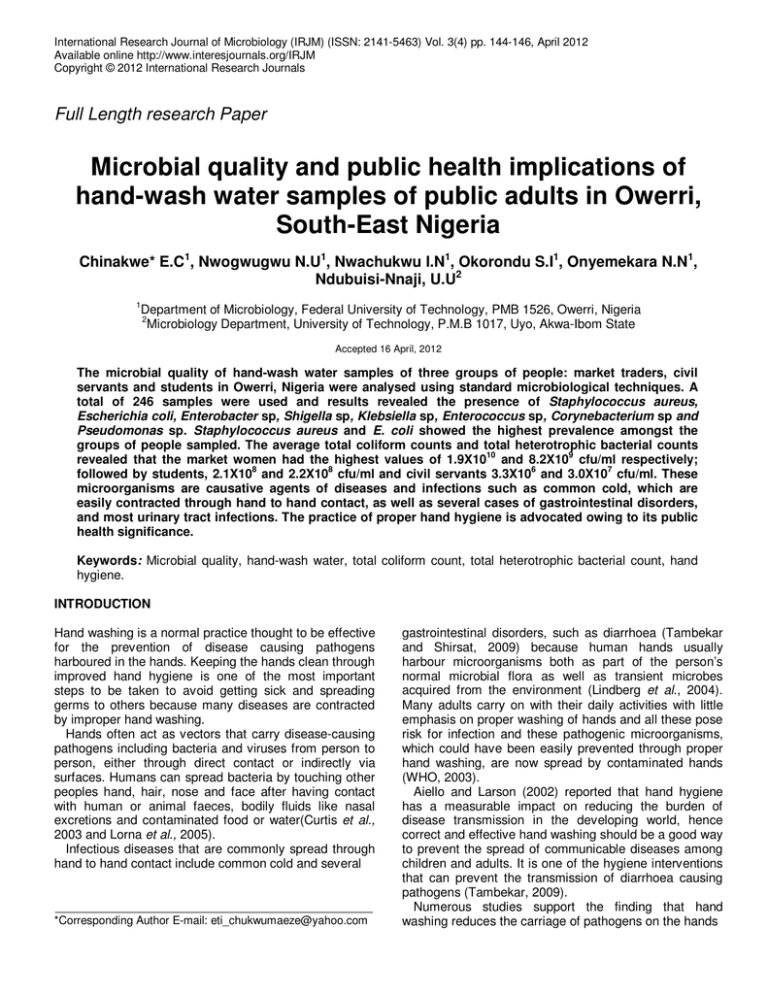
International Research Journal of Microbiology (IRJM) (ISSN: 2141-5463) Vol. 3(4) pp. 144-146, April 2012 Available online http://www.interesjournals.org/IRJM Copyright © 2012 International Research Journals Full Length research Paper Microbial quality and public health implications of hand-wash water samples of public adults in Owerri, South-East Nigeria Chinakwe* E.C1, Nwogwugwu N.U1, Nwachukwu I.N1, Okorondu S.I1, Onyemekara N.N1, Ndubuisi-Nnaji, U.U2 1 Department of Microbiology, Federal University of Technology, PMB 1526, Owerri, Nigeria 2 Microbiology Department, University of Technology, P.M.B 1017, Uyo, Akwa-Ibom State Accepted 16 April, 2012 The microbial quality of hand-wash water samples of three groups of people: market traders, civil servants and students in Owerri, Nigeria were analysed using standard microbiological techniques. A total of 246 samples were used and results revealed the presence of Staphylococcus aureus, Escherichia coli, Enterobacter sp, Shigella sp, Klebsiella sp, Enterococcus sp, Corynebacterium sp and Pseudomonas sp. Staphylococcus aureus and E. coli showed the highest prevalence amongst the groups of people sampled. The average total coliform counts and total heterotrophic bacterial counts revealed that the market women had the highest values of 1.9X1010 and 8.2X109 cfu/ml respectively; followed by students, 2.1X108 and 2.2X108 cfu/ml and civil servants 3.3X106 and 3.0X107 cfu/ml. These microorganisms are causative agents of diseases and infections such as common cold, which are easily contracted through hand to hand contact, as well as several cases of gastrointestinal disorders, and most urinary tract infections. The practice of proper hand hygiene is advocated owing to its public health significance. Keywords: Microbial quality, hand-wash water, total coliform count, total heterotrophic bacterial count, hand hygiene. INTRODUCTION Hand washing is a normal practice thought to be effective for the prevention of disease causing pathogens harboured in the hands. Keeping the hands clean through improved hand hygiene is one of the most important steps to be taken to avoid getting sick and spreading germs to others because many diseases are contracted by improper hand washing. Hands often act as vectors that carry disease-causing pathogens including bacteria and viruses from person to person, either through direct contact or indirectly via surfaces. Humans can spread bacteria by touching other peoples hand, hair, nose and face after having contact with human or animal faeces, bodily fluids like nasal excretions and contaminated food or water(Curtis et al., 2003 and Lorna et al., 2005). Infectious diseases that are commonly spread through hand to hand contact include common cold and several *Corresponding Author E-mail: eti_chukwumaeze@yahoo.com gastrointestinal disorders, such as diarrhoea (Tambekar and Shirsat, 2009) because human hands usually harbour microorganisms both as part of the person’s normal microbial flora as well as transient microbes acquired from the environment (Lindberg et al., 2004). Many adults carry on with their daily activities with little emphasis on proper washing of hands and all these pose risk for infection and these pathogenic microorganisms, which could have been easily prevented through proper hand washing, are now spread by contaminated hands (WHO, 2003). Aiello and Larson (2002) reported that hand hygiene has a measurable impact on reducing the burden of disease transmission in the developing world, hence correct and effective hand washing should be a good way to prevent the spread of communicable diseases among children and adults. It is one of the hygiene interventions that can prevent the transmission of diarrhoea causing pathogens (Tambekar, 2009). Numerous studies support the finding that hand washing reduces the carriage of pathogens on the hands Chinakwe et al. 145 Table 1. Prevalence of bacterial species isolated from hand – wash water samples. Bacterial species Enterobacter Staphylococcus Shigella Klebsiella Enterococcus Escherichia Corynebacterium Pseudomonas Market women % 30(35) 70(82) 10(12) 35(41) 45(53) 60(71) 15(18) 57(67) 85 (Rottee 1999 and Cooper et al., 1999). However, several studies have found that hand washing is poorly practiced outside the healthcare profession, indicating a need for awareness in the society (American Society of Microbiology, 2005). This work seeks to study the microbial quality and public health significance of hand wash water samples of adults including market traders, civil servants and students in Owerri, Nigeria. MATERIALS AND METHODS A total of 246 hand wash water samples were aseptically collected from different randomly selected adults – market traders, students and civil servants, between January 2011 and June 2011. Hands were washed thoroughly in the usual manner with sterile water only, into sterile containers. The samples were serially diluted and 0.1ml of the 10-6 dilution of each sample was inoculated differently onto MacConkey agar and Nutrient agar plates, uniformly spread and incubated at 37OC for 24 hours. After incubation, the number of colony forming units was counted and different types of colonies were isolated. The distinct colonies were identified on the basis of morphology, cultural characteristics and biochemical tests (Collins et al.,1989). RESULTS AND DISCUSSION Hand hygiene is an important public health issue and of great concern to everybody. Microbial contamination of the hands has become a global health problem despite all the public health campaign that promotes washing of hands. The hand wash water samples from the 246 adults sampled revealed pathogenic bacterial contamination of the hands (Table 1). Staphylococcus aureus and E. coli showed the highest prevalence amongst the three groups sampled – market women, civil servants and students. Civil Servants % 15(19) 47(60) 00(00) 25(32) 14(18) 20(26) 06(08) 20(26) 78 Students % 30(36) 50(60) 10(12) 25(30) 20(24) 48(58) 10(12) 35(42) 83 Tambekar et al. (2007) and Mensah et al. (2002) had reported that defective personal hygiene can facilitate the transmission of these pathogenic bacteria found in the environment to human hands. The number and types of bacteria obtained from the hand-wash water samples are comparable to those reported by Didier (2001). The water samples of market women were more contaminated than other samples. This could be as a result of exposure and contact to various formites they come in contact with while doing business. Aiello et al. (2004) had reported the occurrence of Enterobacter, Staphylococcus and Klebsiella spp. on the hands. Tambekar et al. (2009) further reported the presence of E. coli, Pseudomonas sp, Proteus sp, Citrobacter sp, and Salmonella sp from the hand swab of students. Students do not wash their hands often or too well; they play indoor and outdoor games and come in contact with contaminated surfaces coupled with the home and school environment that are of particular concern for the transmission of infection among students. Unfortunately, too, most schools in developing countries do not provide appropriate hand washing facilities and where these facilities are available; they may be poorly located, inaccessible or improperly used. The average total heterotrophic bacterial counts and average total coliform counts were high for hand wash water samples of market women followed by students and then civil servants (Table 2). Numerous studies support the carriage of high numbers of pathogens in the hand of individuals due to improper hygiene (Rotter, 1999; Prescott, 2005; Tambekar and Shirsat, 2009 and Judah et al., 2010). The isolation of pathogenic organisms in the hand wash water samples is of great public health importance because they can cause infection and diseases. Staphylococcus aureus is the commonest cause of food poisoning resulting to a noisy stomach, irritated bowel, vomiting as well as nausea and diarrhoea (Prescott et al., 2005). Pseudomonas species are opportunistic pathogens that can invade surgical wounds, burns and the 146 Int. Res. J. Microbiol. Table 2. Average Bacterial Counts Bacterial Counts Coliform count (cfu/ml) highest count lowest count average count Total Heterotrophic - Bacteria count (cfu/ml) -highest count Market Women lowest count average count Civil Servants Students 3.5X10 2.2X106 10 1.9X10 9 4.5X10 30X106 6 3.3X10 7 1.7X10 2.4X105 8 2.1X10 10 5.7X10 4.4X106 7 3.0X10 7 6.3X10 5.1X106 8 2.2X10 3.0X10 8.7X108 9 8.2X10 9 8 The presence of Pseudomonas sp, E. coli, and other coliform bacteria could be due to improper personal hygiene and unhygienic surroundings. lungs while Klebsiella sp, Enterobacter sp, E. coli and Shigella sp can cause urinary tract infection and gastroenteritis respectively (Tambekar and Shirsat, 2009). CONCLUSION This study has shown clear evidence of the presence of pathogenic organisms in the hand-wash water samples. Hand washing is the simplest and most effective measure for preventing the spread of bacteria. Most of the isolated organisms from this study: E. coli, S. aureus, Pseudomonas sp, Shigella sp and Enterobacter sp etc, are responsible for food–borne and diarrhoeal diseases. Also most people do not wash their hands before handling or eating food, after visiting the toilet and playing with animals, etc. It is therefore very important for public health establishments and nongovernmental organizations that promote healthy living to intensify the campaign promoting the washing of hands because of its obvious benefits. REFERENCES Aiello AE, Marshall B, Levy SB, Della-Latle P, Larson E (2004). Relationship between Triclosan and susceptibilities of bacteria isolated from hands in the community. Antimicrob. Agents Clemothera 48(8):2973-2976. American Society of Microbiology (2005). Another U.S. airport travel hazard - Dirty hands. ASM News 71(12). Burton M, Cobb E, Donachie P, Judah G, Curtis V, Schmidt W (2011). The effect of hand washing with water or soap on bacterial contamination of hands. Intern. J. Environ. Res. Public Health 8(1):97-104. Collins CH, Lyne PM, Grange J (1989). Collins an Lynes Microbiological th methods ,6 edn.Butterworth and Co. Ltd. London. Cooper BS, Medley GF, Scott GM (1999). Preliminary analysis of the transmission dynamics of nosocomial infections. J. Hospital infect. 43: 131-147. Curtis V, Carncross S (2003). Effect of washing hands with soap on diarrhoea risk in the community: A systemic review. The lancet infections diseases 3:275-281. Didier P (2001). Improving adherence to hand hygiene: A multidisciplinary approach. Emerging Infectious Diseases 7(2)-2001 March-April. http://wwwnc.cdc.gov/eid/article/7/2/70-0234.htm. Judah G, Donachie P, Cobb E, Schmidt W, Holland M, Curtis V (2010). Dirty hands: bacteria of faecal origin on communities hands. Epidemiol. Infect. 38(3): 409-414. Lindberg E, Adlerberth I, Hesselmen B, Saalman R, Strannegared I, Aberg N, Wold A (2004). High rate of transfer of Staphylococcus aureus from parental skin to infant gut flora. J. Clin. Microbial. 42:530-534. Lorna F, Kaufmann RB, Kay D, Enanoria W, Haller D Colford JMC Jr. (2005). Water, sanitation and Hygiene intervention to reduce diarrhea in less developed countries: A systemic review. The Lancet infectious diseases 5(1):42-52. Mensah P, Mann DY, Danko KO, Ablodey A (2002). Street foods in Ghana. How safe are they? Bull. World Health Organ. 80(7):546-584. th Prescott LM, Harley JP, Clems DA (2005). Microbiology. 6 edition, McGraw Hill company Inc. New York. pp. 960. Rotter M (1999). Hand washing and Hand disinfection. Mayhall C.G. (ed). Hospital epidemiology and infection control. Lippincott William and Wilkins. Pp. 1339-1335. Tambekar DH, Shirsat SD (2009). Hand washing: A cornerstone to prevent the transmission of diarrhoeal infections. Am. J. Med. Sci. 1(3):100-103. Tambekar DH, Shirsat SD, Kakde SR, Ambekar KB (2009). Hand hygiene and health: An epidemiological study of students in Amravati: Afr. J. Infect. Disinf. 3(1):26-30. Tambekar DH, Shirsat SD, Suradkar SB, Rajankar PN, Banginwar YS (2007). Prevention and transmission of infectious disease: Studies on hand hygiene in health care among students. Cont. J. Biomed. Sci. 1:6-10. WHO (2002). Healthy villages – A guide for communities and community health workers. World Health Organization.
